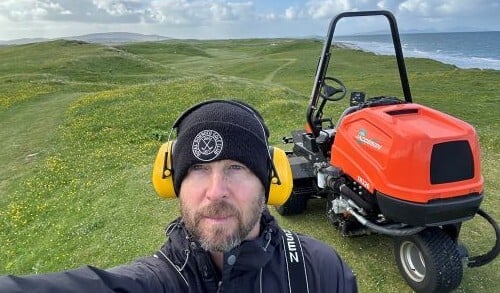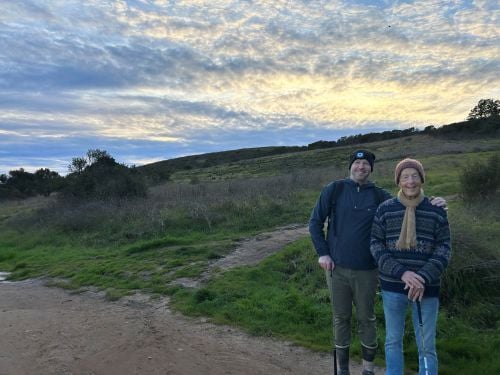
A Mission to Bring Golf Back to Pogonip Open Space in Santa Cruz is Underway
By Nick Lozito
Isaac Weintraub was done with greenkeeping, or so he thought.
Frustrated by luxury golf’s “arms race to be perfect” – a year-round pursuit of green fairways and fast greens – that left him coughing and vomiting from the pesticides, Weintraub returned to coaching.
Then in 2022, after failing to qualify for The British Open at St. Andrews, a two-week exploration of Scotland rekindled the 42-year-old’s passion for golf’s environmental sustainability and community benefits. At Askernish Golf Club, a restored Old Tom Morris design on the Western Isles of Scotland that practices chemical-free greenkeeping by using natural cow fertilizer and sheep grazing, Weintraub saw the game as it was enjoyed a century ago.

“It captured my imagination,” said the Santa Cruz native, who returned to work at the course the past two summers, mowing fairways – without coughing from pesticides – and giving lessons to locals.
Weintraub now hopes his experiences in Scotland can help restore a lost course in his hometown.
Pogonip Open Space, a 600-acre Santa Cruz park with hiking trails and community gardens, hasn’t housed a golf course since Casa Del Rey Golf Club closed in the mid-1930s, shortly after the opening of nearby Pasatiempo in 1929. Weintraub’s plan is to restore 10-to-12 holes of designer Tom Bendelow, a friend of Old Tom Morris, on about 80-100 acres. He is working to raise $30,000 in seed money to develop a golf course plan with Parker Anderson, founder of Santa Barbara-based Greener Golf, and hire a local architect to develop an overall site plan.
“The bones are still there,” Weintraub says of the course. “I want to bring what I learned at Askernish to Santa Cruz and show the heart and soul of golf.”

Obstacles facing the restoration include soil contamination, which Anderson discovered on his visits, homeless encampments, streets needing repair and, of course, approval from the city council.
Anderson and Weintraub connected through Shivas Iron Society, a Carmel-based organization that “promotes mindfulness within golf,” explains Anderson, whose work with Greener Golf includes safely relocating the bee colonies at Goat Hill Park Golf Club in Oceanside and working with University of Michigan on a sustainability map for Roderick Farms Golf Course in Ann Arbor.
“It’s an exciting project,” Anderson said of Pogonip, which he lauded for its “incredible landscape and terrain” after walking the site on several occasions with Weintraub. “This is an opportunity to showcase golf as something different than the norm. Projects like these are very rare.
“I see golf as a mechanism for connecting people to nature and building community. There is a way to have an incredible course that has a connection to the ecosystem and enhances it.”
In presenting the Pogonip vision to a rotary club in May, Weintraub shared his personal story: Playing Pasatiempo as a kid, then at Santa Cruz High School and San Jose State before cutting his teeth on PGA Tour Canada; a yearlong internship at Augusta National Golf Club, where he mowed greens six times per day, filled divots and raked bunkers in preparation for the 2015 Masters; earning his Master in Turf Science at Penn State; and the rejuvenating trip through Scotland.
“One guy was operating, so I doubled their output,” Weintraub said of first working at Askernish, where his mind soon went to Pogonip. “The course went from shabby to a little better. ... Golf doesn’t have to hinge on perfect greens and green grass. Guess what? You might have to hit your putt a little harder.”
Might one course restoration lead to another?

After Casa Del Rey Golf Club closed in the 1930s, Pogonip became polo fields, according to the City of Santa Cruz website, and then a rehabilitation area for servicemen after World War II. The clubhouse, a historical building perhaps best known as the hangout in the 1980s cult movie “The Lost Boys,” is currently deemed “structurally unsafe.”
“I want to create a safe space for people to get outside,” Weintraub said.
Traci Bliss, a Santa Cruz historian, brings optimism.
“The old cannery building is now a climbing wall,” Bliss, a professor emeritus, points out. “The old sash mill has been repurposed into small commercial areas and office spaces. The leather tannery is now an arts center. The idea of taking an iconic structure and reimagining it for a contemporary purpose is consistent with the culture of Santa Cruz, especially at a time when we’re becoming more of a big city. We have more building and less open space.”

Bliss believes Weintraub’s vision aligns with the original mission of Pogonip.
Poponip was founded to be a golf experience for everyone,” explained the historian whose family, including great-great aunt Jennie Bliss Jeter, were among the club’s founding members. “The blue-collar experience that everyone could have access to golf. What people in Santa Cruz are excited about is that Isaac’s vision will bring that vision back, of making golf widely accessible.”
Scott Berlin, a youth golf advocate, said a restored Pogonip course could serve as a home for Santa Cruz Junior Golf, and help a region that has lost nine-hole courses in Aptos and Scotts Valley. Plans call for the clubhouse to be an education center.
“There is a rich history at Pogonip,” Berlin said. “It would be wonderful to bring that back to life.”